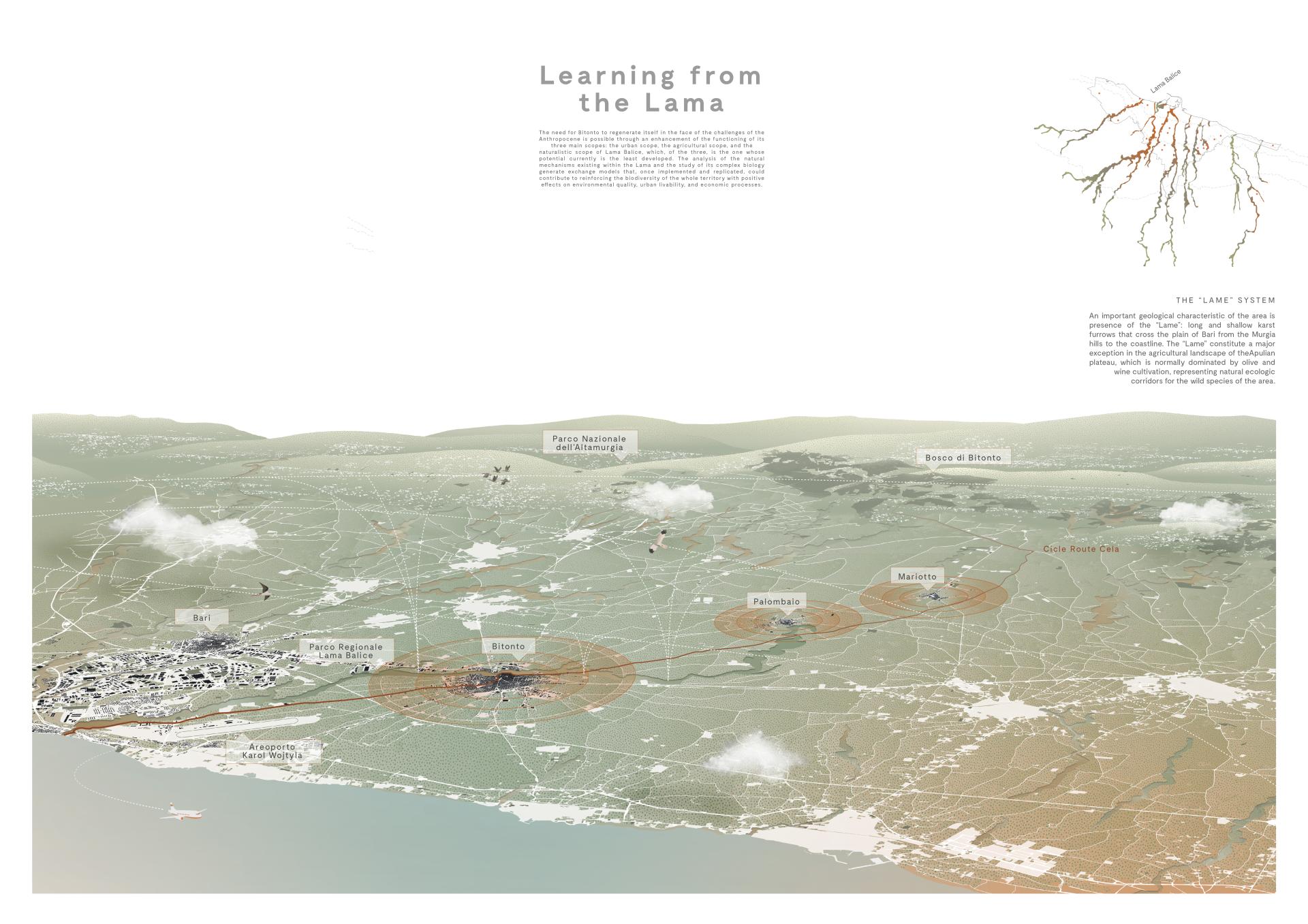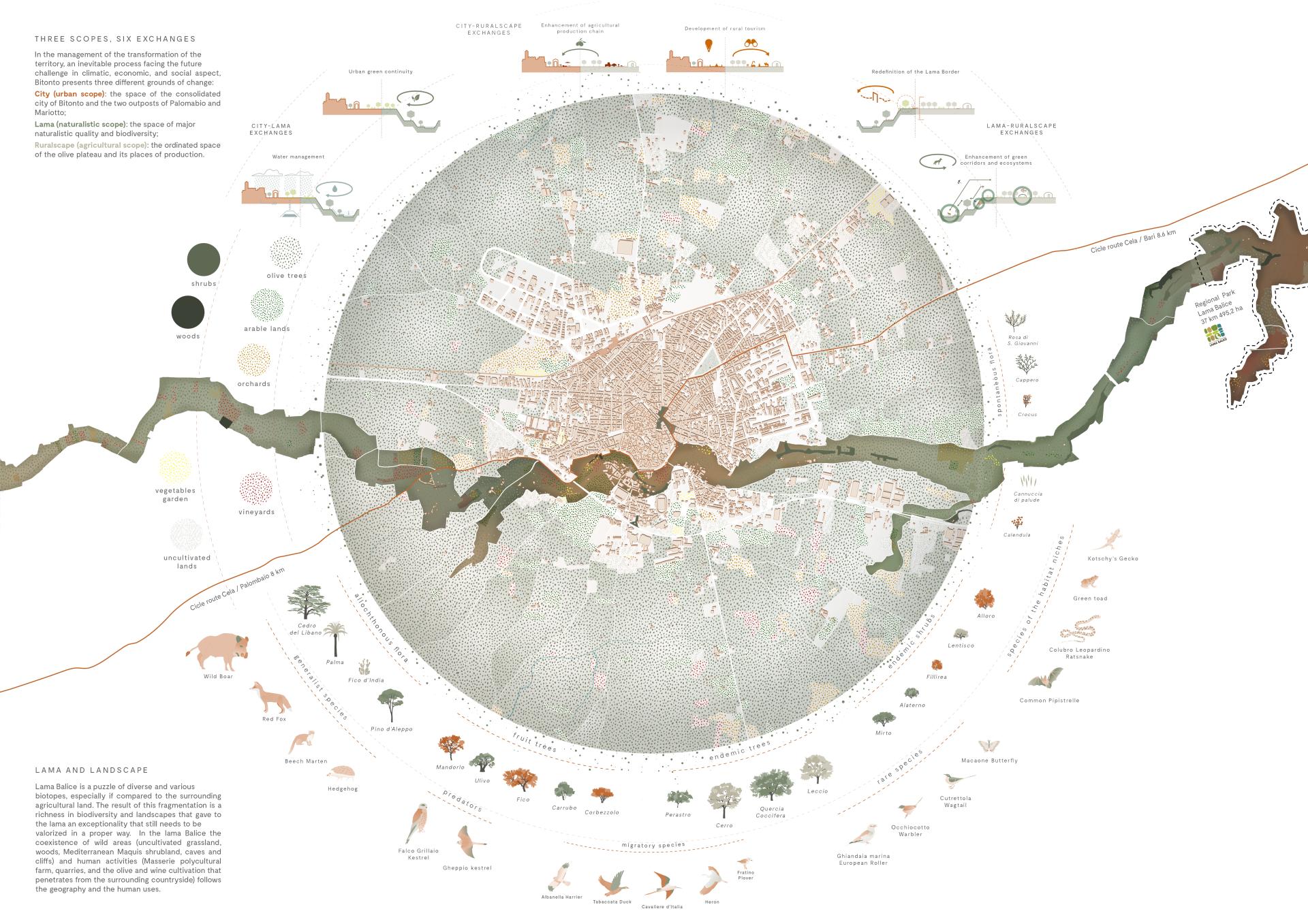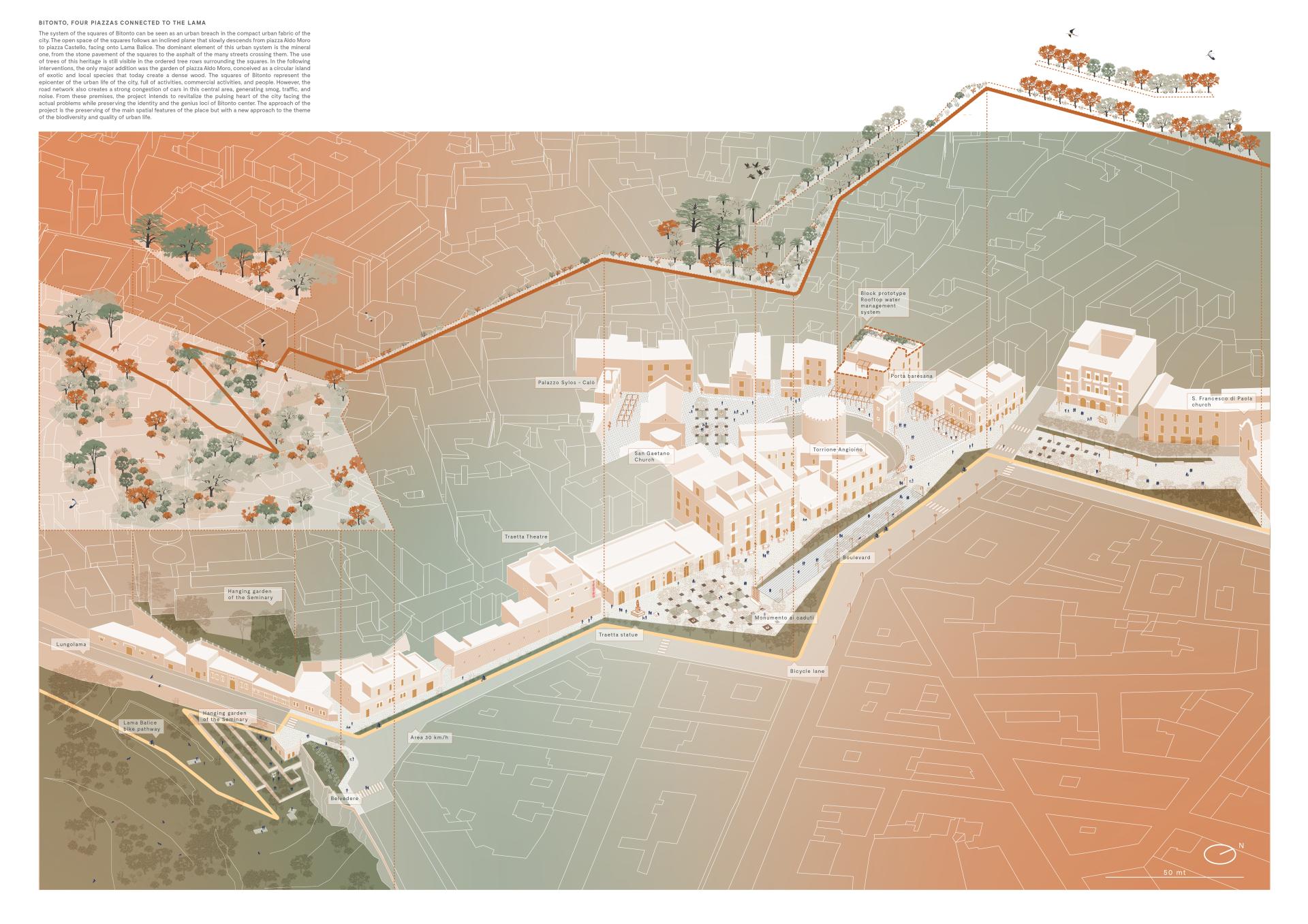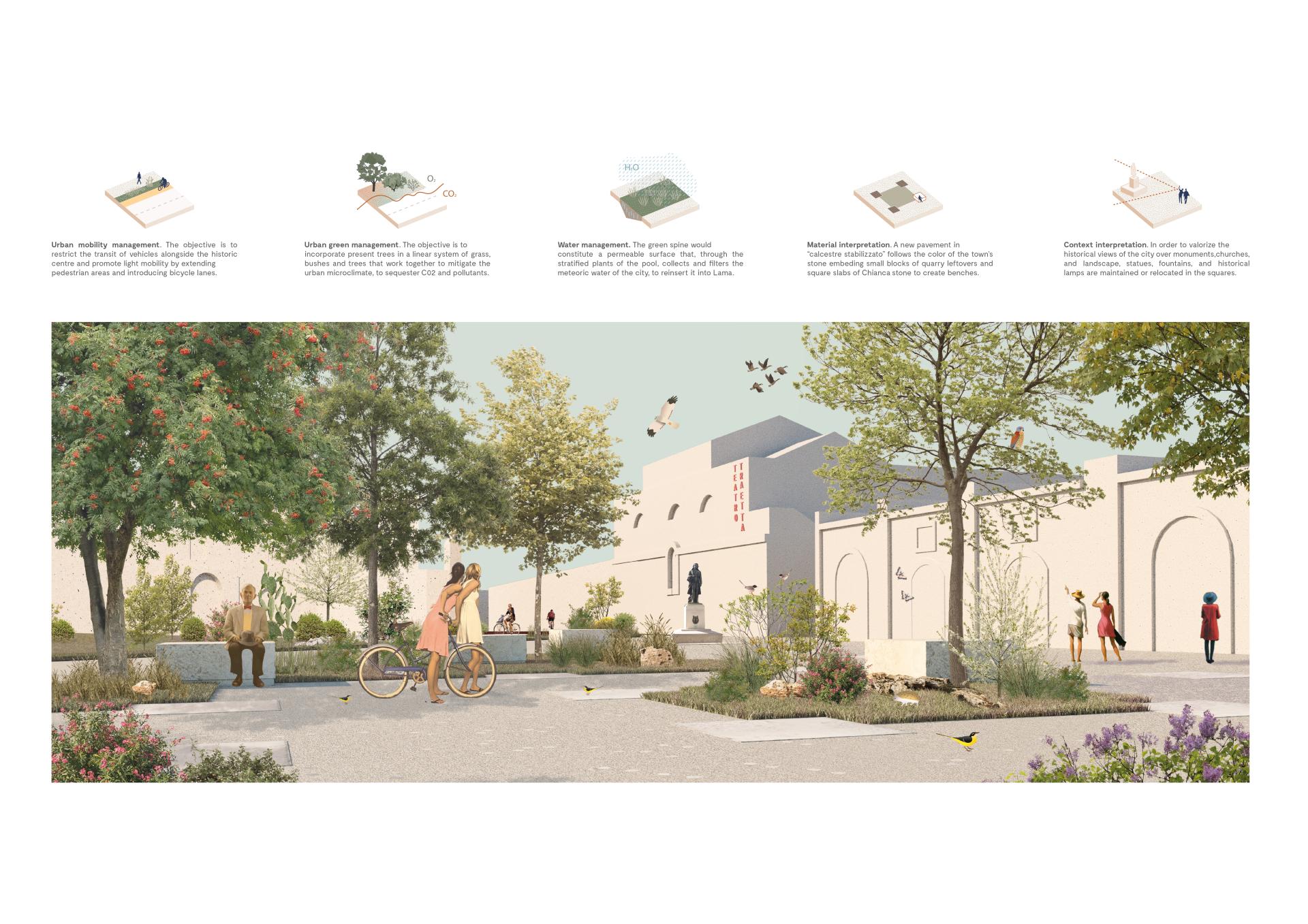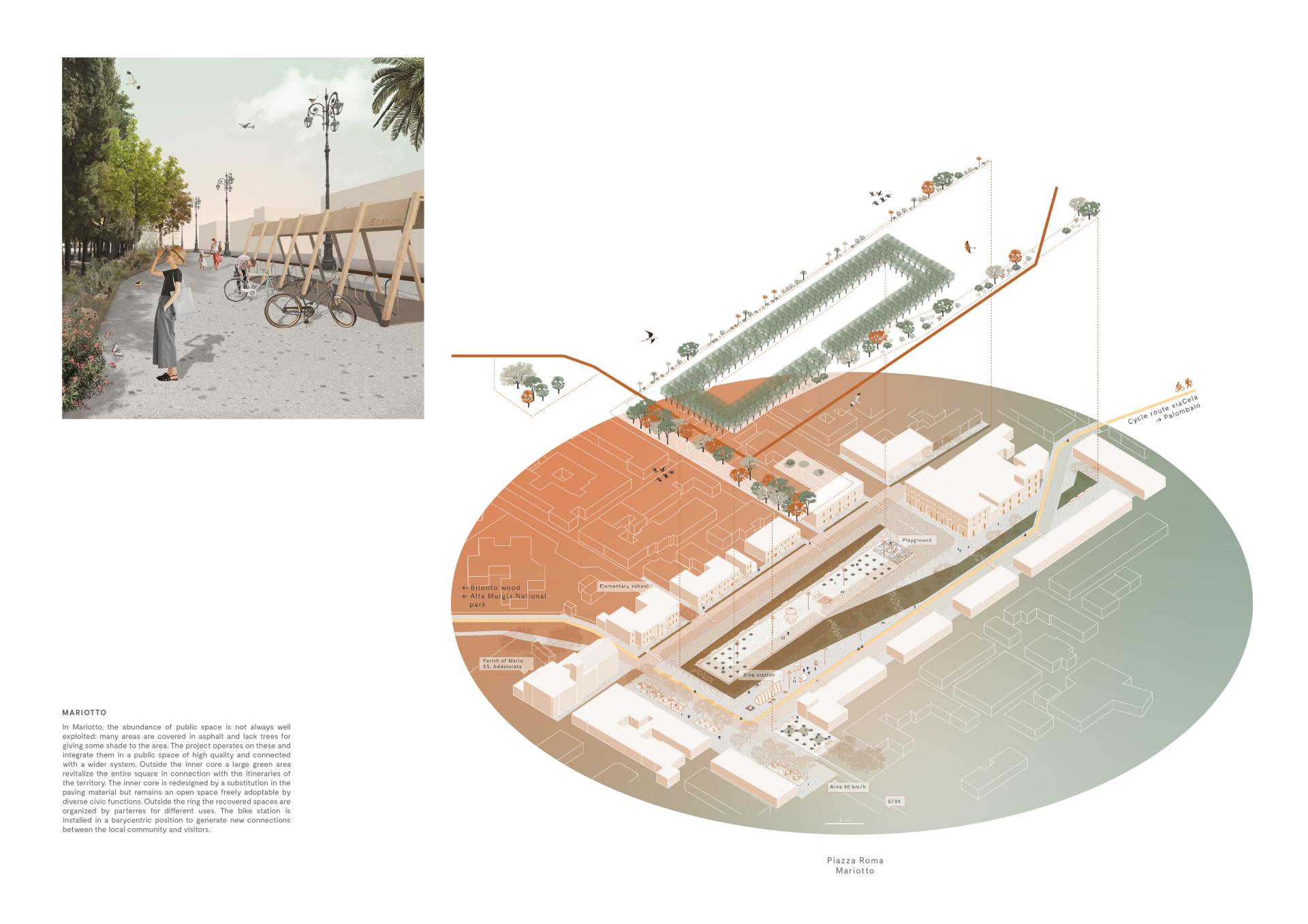Learning from the Lama
Basic information
Project Title
Full project title
Category
Project Description
The need to regenerate Bitonto in the light of the Anthropocene is possible through an enhancement of the functioning of its three main scopes: the urban scope, the agricultural scope, and the natural scope of Lama Balice. The analysis of the natural mechanisms and the study of the Lama biology generate exchange models that, once implemented and replicated in the public spaces, could contribute to reinforcing the biodiversity with positive effects on environmental quality an urban livability.
Geographical Scope
Project Region
Urban or rural issues
Physical or other transformations
EU Programme or fund
Which funds
Description of the project
Summary
The project “Learning from the Lama” is a urbanism and architecture project that proposes for the city of Bitonto a strategic view for the regeneration of its territory and a specific redesign of the key public spaces of the city, in the framework of Europan 16 – Living Cities competition.
The “reinforce biodiversity” theme given by Europan 16 to regenerate the city of Bitonto and its hamlets is interpreted through the analysis of the mechanisms that regulate the territory, developing processes between the areas of exchanges and their context.
Starting from an analysis of the values of the three scopes (urban scope, natural scope of Lama Balice and agricultural scope of the countryside of the oil production) the project seek the best approach in a new asset of the territorial strategy.
Of the three systems of the Bitonto territory, Lama Balice is the one with the major possibilities of development. A Lama, in the Apulian context, is a long and shallow karst furrow that crosses the Bitonto territory, making for a unique landscape, as well as the major biodiversity basin of the surrounding area. This marginal ecosystem can be regarded as the privileged ground upon which the transformation of the city may take place.
The project Learning from the Lama aims to provide a suitable and adaptable approach to the city, through the study of its current rich ecosystem, condensing the major strategy into local interventions in the squares of Bitonto and its hamlets Palombaio and Mariotto.
At present day, the piazzas in which the project intervenes are characterized by the presence of a lot of vehicle traffic, large concrete surface and few trees. To throw the city to the future changes, the project intends to act the regenerative processes to transform the piazzas into green spaces surrounded by slow mobility systems.
Key objectives for sustainability
The project takes the concept of environmental sustainability at various levels, but over all is sustainable in the intention to work as much as possible at a local scale, valorising the existing through regenerative processes. The project addresses the issue of the modes of exchange between urban, natural and agricultural land, with the aim to enhance the functioning of the ecosystems.
The management of the ecosystem and the surrounding countryside must enhance the role of the Lama as biogenetic reserve and natural ecological corridor for many species. A functioning ecosystem has effects on the environmental goods that furnish to the people ( as the quality of the soils and its product and the prevention of extreme weather conditions and mitigation of local microclimate).
In the making of the project, the correct use of the natural, mineral elements, and the water, has achieved the choice of practices that can be sustainable and promoter of a new balance for Bitonto biodiversity.
- The choice of the green elements is made proposing in the city the species for Lama Balice and species that can coexist in a urban landscape mad of three, shrubs and bushes that can generate shadow, absorb CO2 and constitutes a green corridor in the city.
- The green spine helps the city to recuperate water resources, collecting water and redistribute in the lama when need.
- In the materials of the project the choice is on recycled component, as the cave wastes that will constitutes part of the paving of the squares.
- The mobility system is studied to promote slow and cycle mobility, reducing the cars, and the pollution, noise and hot that they generate.
Key objectives for aesthetics and quality
By the individuation of a link between the public space existing between Bitonto and Palombaio and Mariotto hamlets, the presence of Lama Balice is the occasion to contaminate the urban spaces with the surrounding landscape, introducing in the city new aesthetic qualities linked to the nature.
The interventions develop themselves into squares that presents important historical heritage, but with the presence today of big part of them with busy streets and parking. The few trees are single plants that surround the inner squares. Our intervention intends to preserve and enhance the most important historical view towards monument and landscape and integrate in the project the monument and other historical artifact in a new pedestrian and green extension of public spaces that reduce the asphalt for the public life.
The experience of the square is improved by the presence of green and by the introduction of new area and seats, that for shapes and materials (in particular local stone) dialogue with the surrounding context.
Key objectives for inclusion
The proposal integrates the project in a system that involves the undergoing urban programs by the municipality, that is actually working for a more liveable and inclusive city. The project intervenes on a system of spaces to make them inclusive, accessible, safe and attractive to different use, formal and informal, for all the citizen and users that has the square as common ground. The space of the piazzas, in the plurality of their use, are conceived to be the place of the sharing and cohabitation. The continuity of the green system and the unique continuous pedestrian surface that remove gaps and reduce the street crossing makes the more spaces accessible to every kind of people, in particular children and elder people that can better experience the public space. The regeneration of entire square and street is an important boost for the economic activities facing those space. In particular in the hamlets, the promotion of cycle touristic and gastronomic itineraries in the countryside can create new activities in Palombaio and Mariotto, in the field of cycle services and promotion of food, oil and wine goods. The local communities are an important key element in this process, with the objective to reduce the gap between centre and periphery and to reinforce the 0 km production chain.
The project is inclusive also in the process of development. In the making are foreseen initiatives of bottom-up dialogue with the citizens, through the use of participative balance in the definition of aspect of the project at the smaller scale.
Physical or other transformations
Innovative character
In comparison to the projects of the last century, today the possibilities of a regeneration pass through a process of rethinking of the ecological and biological aspect. In this sense the component that are useful to guarantee an implementation of the sustainability become themselves elements of redefinition of the space in a contemporary way.
The green spine as an extension of the Lama Balice, the key element of the project keeps together the sustainability element in as a green infrastructure itself, the aesthetic quality given by the vegetation and the materials and the social inclusion element, by the qualitative regeneration of public parts of the city and its economic activities.
The redefinition of the space of the Lama Balice, and the introduction of light infrastructures for slow mobility, makes the area more accessible to every kind of people and more attractive in the territory dynamics. The projects at the same time improves the quality of the experience to the city users and guarantee an implementation of the exchanges between ecosystems.
Lama Balice, a self-regenerative landscape is the key element to start a local regeneration not only of the city itself, but also for the hamlets, that can be more competitive in the attraction of people and activities.
The contamination of all the elements reinforces the consciousness for the people living in the public space respect to the conservation of the habitats and the value of the biodiversity as engine of the urban and social development. A society conscious and participative of the processes is capable of valorise the resources of their territory.

